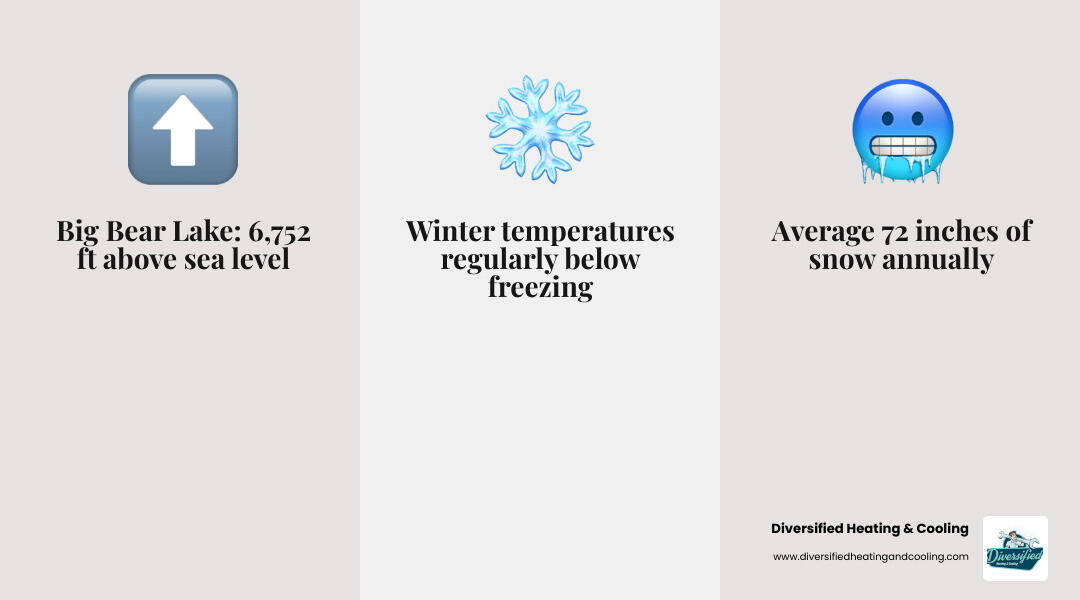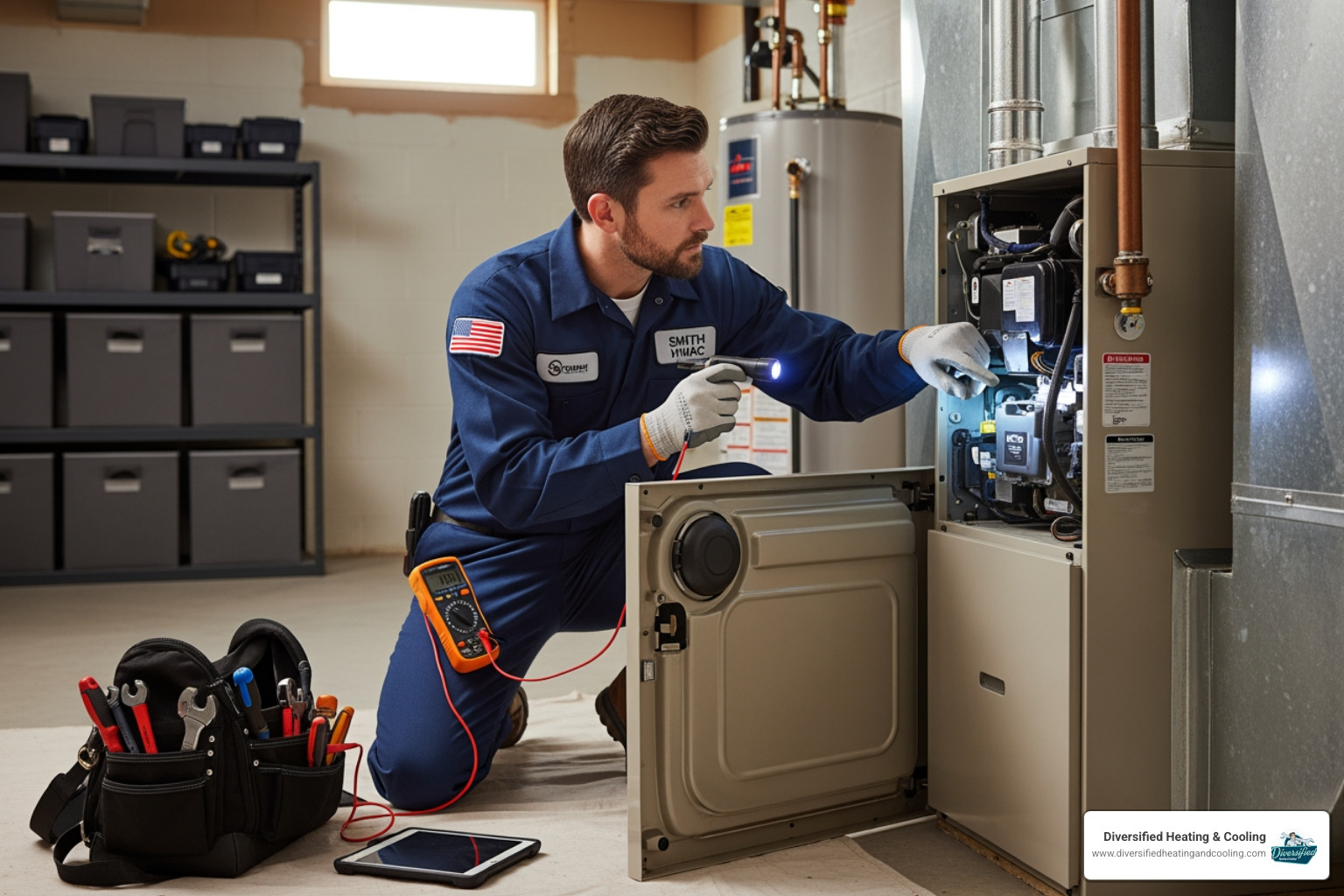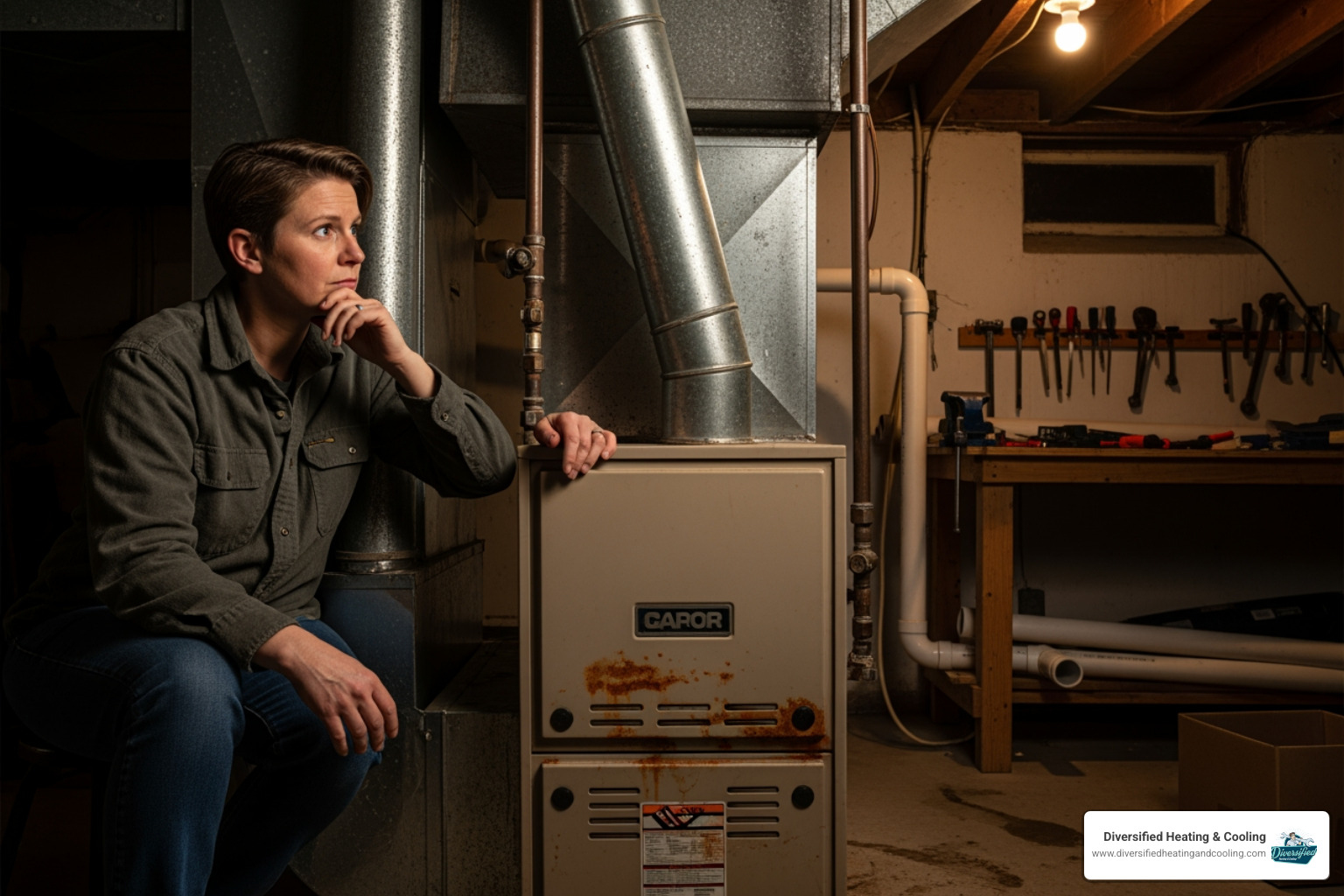Why Heating Maintenance Matters in Big Bear’s Mountain Climate
Heating maintenance in big bear lake ca is not just recommended—it’s essential for surviving the mountain’s harsh winters. Big Bear Lake sits at 6,752 feet, where temperatures regularly drop below freezing amid an average of 72 inches of annual snowfall. A heating system failure in these conditions is more than uncomfortable; it can be dangerous. Regular maintenance prevents unexpected breakdowns, improves energy efficiency, and can extend your system’s life by up to five years.
If you’re looking for professional heating maintenance in Big Bear Lake CA, here’s what you need to know:
- Schedule annual maintenance in early fall before winter arrives
- Look for warning signs like strange noises, uneven heating, or rising energy bills
- Choose a qualified technician who understands high-altitude heating challenges
- Expect a thorough inspection of your heat exchanger, burners, electrical connections, and safety controls
- Consider system age when deciding between repair and replacement (most systems last 15-20 years)
For comprehensive tips on preparing your system for winter, check out our Heating Service Tips to Help You Prepare for Winter.
Big Bear’s extreme climate—high altitude, freezing temperatures, and heavy snow—puts extra strain on heating systems. Reduced oxygen at elevation makes furnaces work harder, and vacation homes risk frozen pipes. This makes professional maintenance more critical here than in lower-elevation areas.

Why Regular Heating Maintenance is Non-Negotiable in Big Bear
In Big Bear Lake, where winter brings freezing temperatures and heavy snow, your heating system is a lifeline. That’s why heating maintenance in Big Bear Lake CA is non-negotiable. A heater failure at 6,752 feet can become a safety emergency, leading to burst pipes and dangerously low indoor temperatures. Regular maintenance catches small problems before they become crises.
Beyond prevention, a well-maintained system runs more efficiently, lowering your utility bills during Big Bear’s long winter. Consistent care can also extend your system’s lifespan by up to five years—a significant value for furnaces (15-30 years) and heat pumps (10-15 years). We recommend scheduling service in early fall to ensure you’re prepared. For a complete guide, see our Heating Service Tips to Help You Prepare for Winter. Safety is also paramount, which is why we perform Ensuring Heating System Safety: Expert Combustion Analysis during maintenance visits.
The Impact of Altitude and Cold on Your System
Big Bear’s 6,752-foot elevation means thinner air and less oxygen for combustion. Your furnace must work harder to produce heat, leading to increased wear and tear on components like burners and heat exchangers. Systems not calibrated for high altitude are under constant strain.
The extreme cold also presents challenges. Heat pump outdoor units can be buried by snow, blocking airflow. Ductwork in unheated spaces is vulnerable, and the risk of frozen pipes is especially high for vacation homes that sit empty. We can help you Get Your HVAC Ready for the Stormy Weather unique to our mountain climate.
Boost Efficiency and Lower Your Energy Bills
Regular heating maintenance in Big Bear Lake CA directly translates to savings on your energy bills. During a tune-up, our technicians focus on peak efficiency. We replace clogged air filters that restrict airflow and waste energy. We also check your thermostat calibration to prevent unnecessary heating. Upgrading to a programmable or smart model can further optimize energy use by adjusting temperatures based on your schedule. Learn more about how Smart Thermostats Enhance Energy Efficiency.
When all components are clean and lubricated, your heater runs for shorter periods, consuming less energy. These combined improvements lead to noticeable savings on your monthly utility bills throughout a Big Bear winter.
Warning Signs: When Your Big Bear Heater Needs Attention
Your heating system often provides warning signs before a complete failure. In Big Bear’s climate, paying attention to these signals is crucial for safety and comfort. Catching problems early can prevent a minor issue from becoming a major system failure, especially when some problems pose immediate safety risks.
Being proactive about heating maintenance in Big Bear Lake CA means learning to recognize when your system needs professional help. While our guide on What to Check First If Your Heater Isn’t Working can help with initial troubleshooting, knowing these deeper warning signs is key.
Common Red Flags for Your Heating System
Unusual noises are a primary indicator of trouble. While your heater should hum quietly, sounds like banging, rattling, squealing, or grinding mean something is wrong. A loud bang at startup can indicate ignition problems, while grinding often points to failing motor bearings.
Strange smells should never be ignored. A brief dusty smell when you first turn on the heat is normal, but persistent burning or metallic odors are not. A sulfur or rotten egg smell may indicate a gas leak, which is an emergency that requires you to leave your home and call for help immediately. For more details, see our article Why is There a Burning Smell When I Turn on the Heat?.
Uneven heating suggests your system is struggling. If some rooms are warm while others are cold, you could have airflow problems, duct leaks, or a failing blower motor. In Big Bear, every room needs to stay warm to prevent frozen pipes.
An unexplained increase in your energy bills is a clear sign of inefficiency. Your system is working harder and consuming more fuel to produce the same amount of heat.
Frequent cycling, where the heater turns on and off repeatedly, puts extreme stress on components. This can be caused by a dirty filter, thermostat issues, or deeper mechanical problems.
For gas furnaces, a pilot light that burns yellow or orange instead of a steady blue is a red flag for incomplete combustion, which can produce dangerous carbon monoxide. This requires immediate professional attention.
Finally, a decline in air quality, such as more dust or worsening allergies, can indicate your system’s filtration is failing. Our guide on What are the Signs of a Furnace Going Out? offers more insight. Acting quickly on these signs can prevent a major failure in the dead of winter.
The Professional Heating Maintenance in Big Bear Lake CA Checklist
When you schedule professional heating maintenance in Big Bear Lake CA, you get a comprehensive inspection to ensure your system is safe, efficient, and ready for winter. This thorough tune-up is designed to provide peace of mind, catching potential issues before they become cold-weather emergencies. Our Residential Heating Service Offerings are custom for mountain living, and we understand why Heating Repair: Why Trust Professionals is vital for your home’s safety.

What a Typical Maintenance Visit Includes
Our technicians follow a detailed checklist covering every critical component. Key tasks include:
- Inspecting the heat exchanger on gas furnaces for cracks that could leak carbon monoxide.
- Cleaning burners to ensure efficient and safe combustion.
- Checking all electrical connections for tightness and corrosion to prevent fire hazards.
- Testing safety controls like limit switches and flame sensors to verify they are operational.
- Lubricating moving parts to reduce friction and prevent premature wear.
- Changing or cleaning air filters for optimal airflow and indoor air quality.
- Verifying thermostat calibration for accurate temperature control.
- Inspecting the flue and vent system for blockages or leaks.
- Checking gas pressure and supply lines to ensure safe operation.
- Inspecting ductwork for leaks that waste heated air.
For more tips, see our guide on 6 Furnace Maintenance Tips to Make Your Winter Warm & Cozy.
Maintenance Needs for Different Heating Systems
We tailor our maintenance to your specific system type:
- Furnaces (Gas/Electric): Gas furnace service focuses on the heat exchanger, burners, and gas lines for safety. For electric furnaces, we inspect heating elements and electrical components. Both types receive blower motor checks and filter changes.
- Heat Pumps: Since they provide both heating and cooling, we check refrigerant levels, inspect indoor and outdoor coils, and verify the reversing valve is working correctly.
- Boilers: We check water pressure, inspect for leaks, flush the system to remove sediment, and test the pressure relief valve.
- Ductless Mini-Splits: Maintenance involves cleaning filters and coils, checking refrigerant lines, and ensuring proper drainage. For more on these systems, see What Maintenance Does a Mitsubishi Mini Split Need?.
No matter your system, our expertise ensures it’s ready for a Big Bear winter.
Repair or Replace? Making the Right Choice for Your Big Bear Home
Every Big Bear homeowner eventually faces the question: repair a struggling heating system again, or invest in a replacement? A new system is a significant investment, but so are repeated repairs on a failing unit. Making the right choice can save you from surprise breakdowns and high energy bills. Our guide on Repairing vs. Replacing Your Home’s Heating System offers more insight into this decision.

Sometimes a repair is the right call, especially for a younger system with a minor issue. However, replacement often becomes the smarter financial move for an aging system needing constant attention. The cost of frequent repairs, combined with higher energy bills from an inefficient unit, can quickly add up.
Key Factors in the Repair vs. Replace Decision
- System Age: Most furnaces last 15-30 years, while heat pumps last 10-15. If your system is approaching or past its expected lifespan, replacement is often the wiser choice.
- Repair Costs: A common rule of thumb is to replace the system if a repair costs more than half the price of a new unit. Major component failures, like a cracked heat exchanger, often make replacement more sensible on older systems.
- Rising Energy Bills: If your bills are climbing without a change in usage, your system is losing efficiency. Modern high-efficiency models can offer significant long-term savings.
- Frequent Breakdowns: If you’re calling for heating maintenance in Big Bear Lake CA multiple times a season, the unreliability and stress may signal it’s time for a new system.
- Comfort Levels: If your system struggles to keep your home warm or runs constantly, it may no longer be able to meet your needs. A new system can restore consistent comfort.
While these signs are for heating, our article 5 Common Signs That You Need to Replace Your AC Unit explores similar indicators for cooling systems. We provide honest information to help you make the best decision for your home.
Frequently Asked Questions about Heating Maintenance in Big Bear Lake CA
Here are answers to some common questions we receive about heating maintenance in Big Bear Lake CA.
How often should I schedule professional heating maintenance?
We strongly recommend professional heating maintenance at least once a year. The ideal time is in early fall, before the winter cold arrives. This proactive approach ensures your system is inspected, cleaned, and tuned up before it’s under heavy demand. An annual check-up helps prevent unexpected breakdowns, improves efficiency, and can extend the life of your system. For more details, see our article How Often Should a Furnace Be Maintained?.
What basic maintenance can I perform myself between professional visits?
Simple tasks can help keep your system running smoothly between appointments. The most important is changing your air filters every 1-3 months, or more often if needed. A clean filter improves airflow and efficiency. Also, keep all supply and return vents clear of furniture or rugs to ensure proper heat distribution. If your thermostat uses them, replace the batteries annually. Finally, visually inspect your outdoor unit, clearing away any leaves, debris, or snow. For more tips, check out our guide on 7 Basic Tips for Fixing Your Heater Like a Pro.
What should I do if my heater fails during a winter storm?
A heater failure during a Big Bear storm requires a quick response. Here’s what to do:
- Prioritize Safety: If you smell gas or your carbon monoxide detector alarms, evacuate immediately and call for emergency help from a safe location.
- Check the Thermostat: Ensure it’s set to “Heat” and the temperature is set higher than the current room temperature.
- Check Circuit Breakers: Look for a tripped breaker in your electrical panel and reset it if necessary.
- Clear Vents: If safe, check that outdoor vents are not blocked by snow or ice.
- Check Fuel: Confirm your gas supply is on or that your propane tank has fuel.
- Call for Emergency Service: If these steps don’t work, call a professional for emergency service. A working heater is essential in Big Bear’s extreme weather. Our article What to Check First If Your Heater Isn’t Working offers more preliminary checks.
Your Partner for a Warm and Safe Winter in Big Bear
Living in Big Bear Lake means embracing its beauty and its challenges. As we’ve discussed, heating maintenance in Big Bear Lake CA is not just a task—it’s a crucial investment in your family’s comfort and safety. Big Bear’s demanding winters, with freezing temperatures and high altitude, place extraordinary stress on heating systems. Proactive maintenance prevents emergencies, manages energy bills, and ensures your heater is reliable when you need it most.
We’ve covered the warning signs to watch for, what a professional tune-up includes, and how to decide between repair and replacement. Understanding Big Bear’s unique climate is key to proper heating system care.
At Diversified Heating & Cooling, we’re your neighbors who understand mountain living. Our family-oriented approach means we treat your home with care, providing honest communication and reliable service.
Don’t wait for the first storm to test your heating system. A proactive approach ensures your family stays warm and safe while avoiding the stress of an emergency repair. For expert, reliable heating services that truly understand the demands of our mountain climate, trust the team at Diversified Heating & Cooling. Contact us today to schedule your service and gain peace of mind for the winter ahead.




